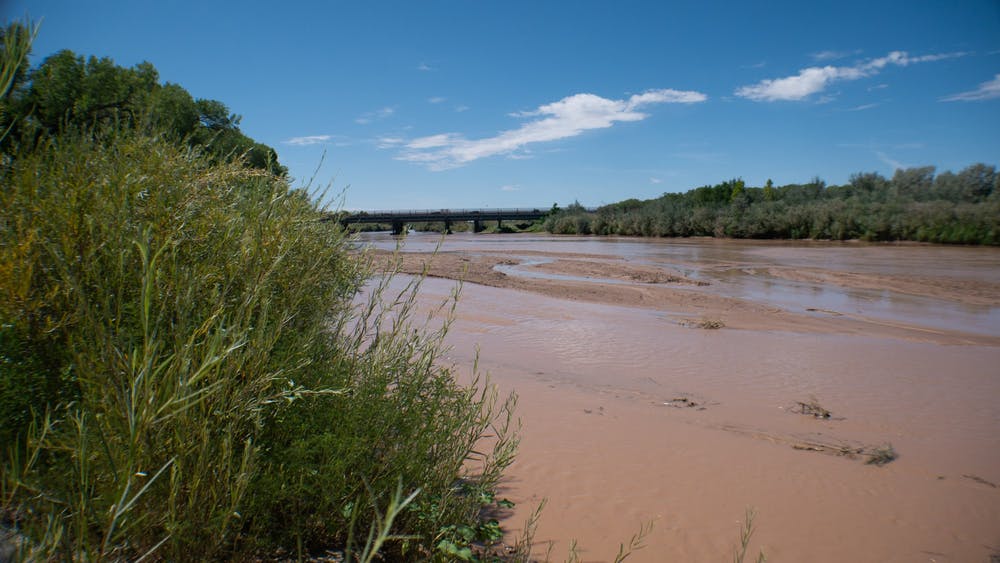
Farmers along the Rio Grande have felt the implications of less water and largely criticize regional laws and decisions that regulate state water usage for limiting access to irrigation.
The Middle Rio Grande Conservancy District board, which manages the water through dams, voted on Aug. 20 to curtail irrigation along the Rio Grande on Oct. 1. However, the law honors Native American pueblo water rights and protects them from the shut-off, according to John Fleck, professor and director of the UNM Water Resources Program.
Now, the Rio Grande in Albuquerque is at its lowest point, for this time of the year, since 1983, according to Fleck. Ricardo González-Pinzón, associate professor of hydrology, said this comes after the river dropped 150 feet in the last 60 years.
Fleck said the state has some complicated societal choices to consider because everyone has different values and ideas about where and how water from the Rio Grande should be used.
“We can’t pray for rain,” Mike De Smet, a dairy farmer in Valencia County, said. “We don’t know what’s going to happen. We need to figure out how to deal with what we have right now.”
The Rio Grande River Compact was signed in 1938 between the states of Colorado, New Mexico and Texas to determine how much water states are allowed to use, according to Fleck.
“When we’re in a debit situation, which we are now in because we’ve been under-delivering water the last couple of years and probably will under-deliver again this year, then there’s a bunch of rules that kick in,” Fleck said. “The rules don’t say ‘you can’t have a debit, ever’; you just have to keep it under a cap.”
In the case of a debit situation, Fleck said rules on what upstream reservoirs are allowed to store are limited.
“Those rules are on table and (there’s) litigation (right now) because there’s a differing interpretation of those rules,” Fleck said. “Texas just filed a motion with the Supreme Court asking to reconsider how everyone’s been interpreting those rules for years in a way that would benefit Texas and harm New Mexico’s ability to use water.”
González-Pinzón emphasized the complexity of this issue, highlighting that there’s not just one answer or solution to consider when addressing drought.
“The requirement for (New Mexico) is to send water into Elephant Butte Reservoir, and that’s where the current conflict is,” Fleck said. “Texas is suing (New Mexico) in the Supreme Court; they argue that we’re managing water in a way that essentially cheats on the terms of the compact by allowing farmers in southern New Mexico to pump a bunch of groundwater.”
Fleck said farmers of southern New Mexico rely on groundwater pumping since “rivers and groundwater are interconnected.” This means that when there’s less groundwater, the water from the rivers is lost to the hole that is left behind by the groundwater pump. De Smet added that flood irrigation by some farmers is a serious misuse of water.
De Smet said farmers are especially vulnerable to the decisions of the Middle Rio Grande Conservancy District board.
“This is how I provide! This is how I live, day to day, for my family,” New Mexico farmer Travis Harris said during public comment at a Middle Rio Grande Conservancy District special meeting on Aug. 20.
With increased greenhouse gases and consequently warming temperatures in an already arid environment, Fleck said the climate will get drier and droughts will be more common.
“There’s clearly climate variability that we would see regardless of us putting out all of these greenhouse gases … but humans have accounted for more than 50% of that variability,” González-Pinzón said.
Fleck said the monsoon season, though not as crucial to our water supply as the snowpack from winter storms, can help significantly because “farmers need less water from irrigation.” Still, although it helps, he said it’s not the long-term solution.
Right now, the southwest is in a “megadrought,” a decades-long period of extreme dryness, according to González-Pinzón.
“Farmers were told they wouldn’t have water as of Oct. 1, which is one month less of water compared to last year — I expect that to keep happening,” González-Pinzón said.
Farmers were asked by the state’s engineer John D’Antonio Jr., who administers New Mexico’s water resources, to consider not farming this year due to the prolonged drought conditions and lack of water, according to Harris.
“There’s not going to be any dairies left besides (De Smet Dairy and Creamery) and, I think, three or four other guys right now, and every one of them are on their way out,” De Smet said. “They’re not going to make it through the year.”























